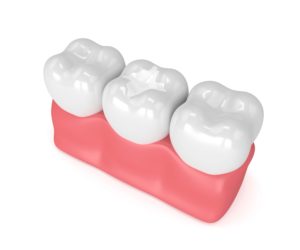 Brampton dentists offer patients different choices of dental fillings. There are different types of fillings used which are based on the client’s condition and preference. Dental fillings are indicated for restoration or repair of dentin, the structure of the tooth beneath the enamel. Accumulation of plaque and bacteria will cause the release of acid that can destroy the enamel of the teeth.
Brampton dentists offer patients different choices of dental fillings. There are different types of fillings used which are based on the client’s condition and preference. Dental fillings are indicated for restoration or repair of dentin, the structure of the tooth beneath the enamel. Accumulation of plaque and bacteria will cause the release of acid that can destroy the enamel of the teeth.
Fillings are used to treat active tooth decay and to prevent the condition from worsening. The molars are the common set of teeth affected by cavities because it is where plaque and cavities usually form. Fillings are typically applied in a single appointment.
Procedure
A dental check-up will be required first for the dentist to assess the severity of the cavity and the number of teeth affected. Tooth decay can cause plaque accumulation in adjacent teeth leading to multiple cavities. This is a typical scenario for chronic and severe tooth decay. Brampton dentists will assess the extent of the cavity present and will note if there is a sufficient tooth structure to hold the fillings. Brampton dentists can further discuss treatment options that will suit the client’s dental needs. The cavities noted during the examination will be removed to prevent further damage to the tooth structure. Fillings will then be applied if there is a sufficient tooth structure remaining.
Common Filling Materials
Composite fillings
Composite fillings are also called white or plastic fillings which are the most commonly used. During the past years, metal and amalgam were used as dental filling materials, but today most dentists offer composite fillings. These are specially manufactured for dental restoration and aesthetic purposes. They are designed to look natural like nearby teeth. The strength of the filling is also considered. The majority of patients have been choosing white fillings because of its aesthetic benefit.
Dentists also offer fillings for patients with cracked, chipped or worn teeth. Dental fillings close a gap or space in the front teeth. The affected tooth will be frozen in preparation of a composite white filling application. The affected or decayed part of the tooth will be removed. The white filling will then be applied on the tooth in layers. Each layer of the composite resin applied will be cured with a light to make the filling dry and stable.
When the filling is already hard and stable, dentists will then polish the filling, and reshape it to restore the tooth’s structure and function. A dentist will also consider the patient’s bite or comfort when polishing the composite filling placed. Composite white fillings need special care and good oral hygiene because they are prone to staining or chipping.
Caring for dental fillings
Dental fillings are designed and made to last several years. Good oral hygiene is still advised even after the application of dental fillings. The fillings applied only serve to replace the lost tooth structure. It cannot prevent future bacterial buildup and plaque formation. Dentists, therefore, emphasize good dental habits like regular brushing and flossing to prevent the formation of future cavities. Regular dental checkups are also recommended to determine the stability of the dental filling that has stayed intact for four years or more.
Other questions and queries about fillings and cavities could be discussed in detail with your dentist.
About Dr. Joseph Salvaggio

Located in Brampton, Ontario Dr. Joseph Salvaggio has been practicing general, cosmetic, and implant dentistry for over 20 years. He enjoys interacting with his patients and helping to restore their oral health for better overall health as well. Meeting new patients, interacting and educating them is one of Dr. Salvaggio’s biggest joys. We encourage you to read our reviews or call us with any dental questions you have. We look forward to speaking with you and meeting you soon.
